Project Management Case Study: Everything But The House (EBTH) - UWL
VerifiedAdded on 2022/05/19
|26
|5751
|54
Case Study
AI Summary
This case study analyzes the project management plan for Everything But The House (EBTH), focusing on the company's e-commerce platform expansion. The study covers various aspects of project management, including human resource needs, stakeholder engagement, project specifications, work breakdown structure, project organization, quality systems, and a project closeout plan. The assignment highlights the importance of project management in facilitating EBTH's global brand rollout, emphasizing the need for specific skillsets like e-commerce marketing and development. It also details stakeholder classifications, power/interest grids, and the importance of managing different stakeholder groups effectively. Furthermore, the study outlines project goals, scope, requirements, and plans, including risk assessments and a project closeout plan, providing a comprehensive overview of the project's strategic approach to ensure successful implementation and minimize operational risks. The case study emphasizes the significance of project management in achieving company objectives, such as expanding into global markets and improving e-commerce capabilities.
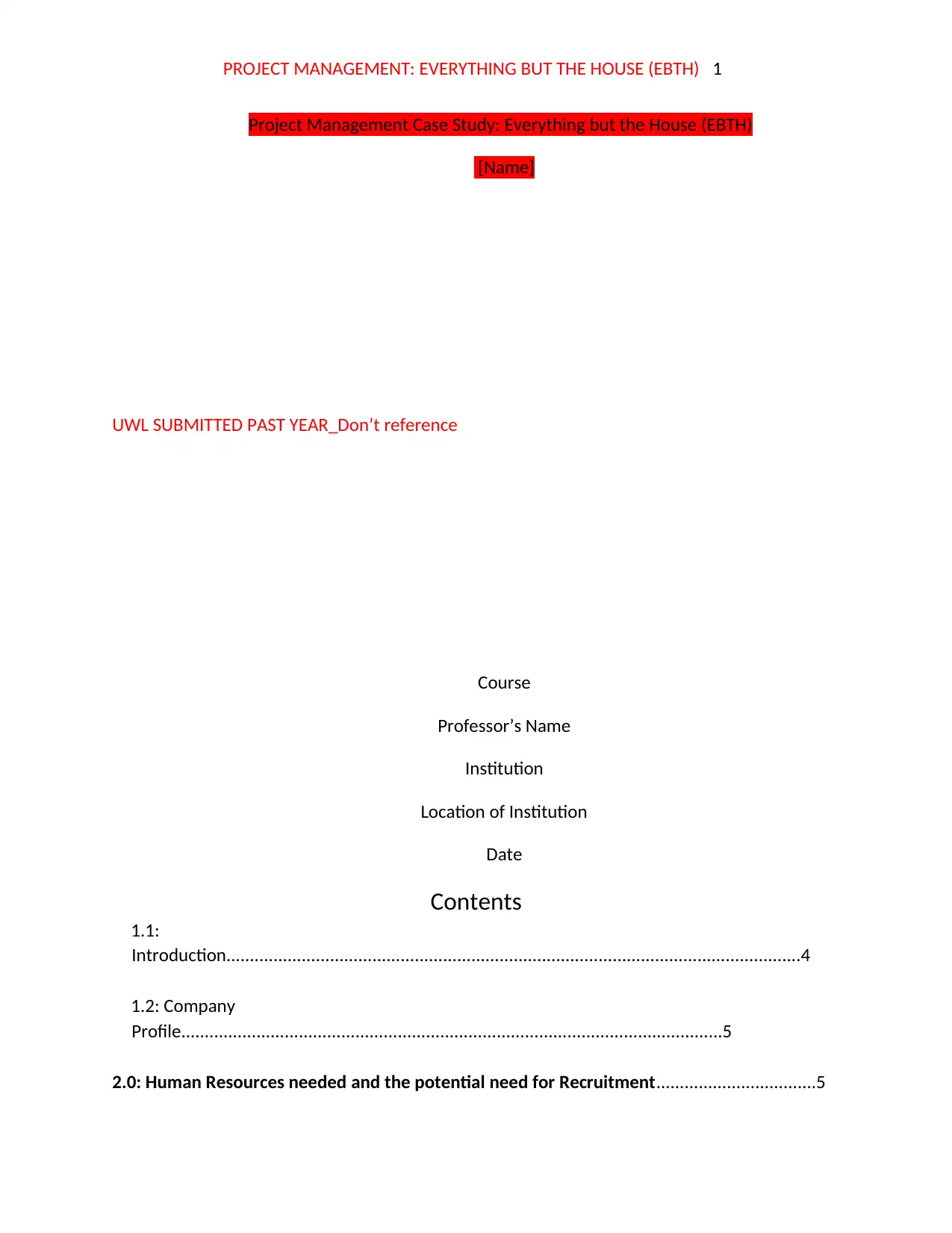
PROJECT MANAGEMENT: EVERYTHING BUT THE HOUSE (EBTH) 1
Project Management Case Study: Everything but the House (EBTH)
[Name]
UWL SUBMITTED PAST YEAR_Don’t reference
Course
Professor’s Name
Institution
Location of Institution
Date
Contents
1.1:
Introduction..........................................................................................................................4
1.2: Company
Profile...................................................................................................................5
2.0: Human Resources needed and the potential need for Recruitment..................................5
Project Management Case Study: Everything but the House (EBTH)
[Name]
UWL SUBMITTED PAST YEAR_Don’t reference
Course
Professor’s Name
Institution
Location of Institution
Date
Contents
1.1:
Introduction..........................................................................................................................4
1.2: Company
Profile...................................................................................................................5
2.0: Human Resources needed and the potential need for Recruitment..................................5
Paraphrase This Document
Need a fresh take? Get an instant paraphrase of this document with our AI Paraphraser
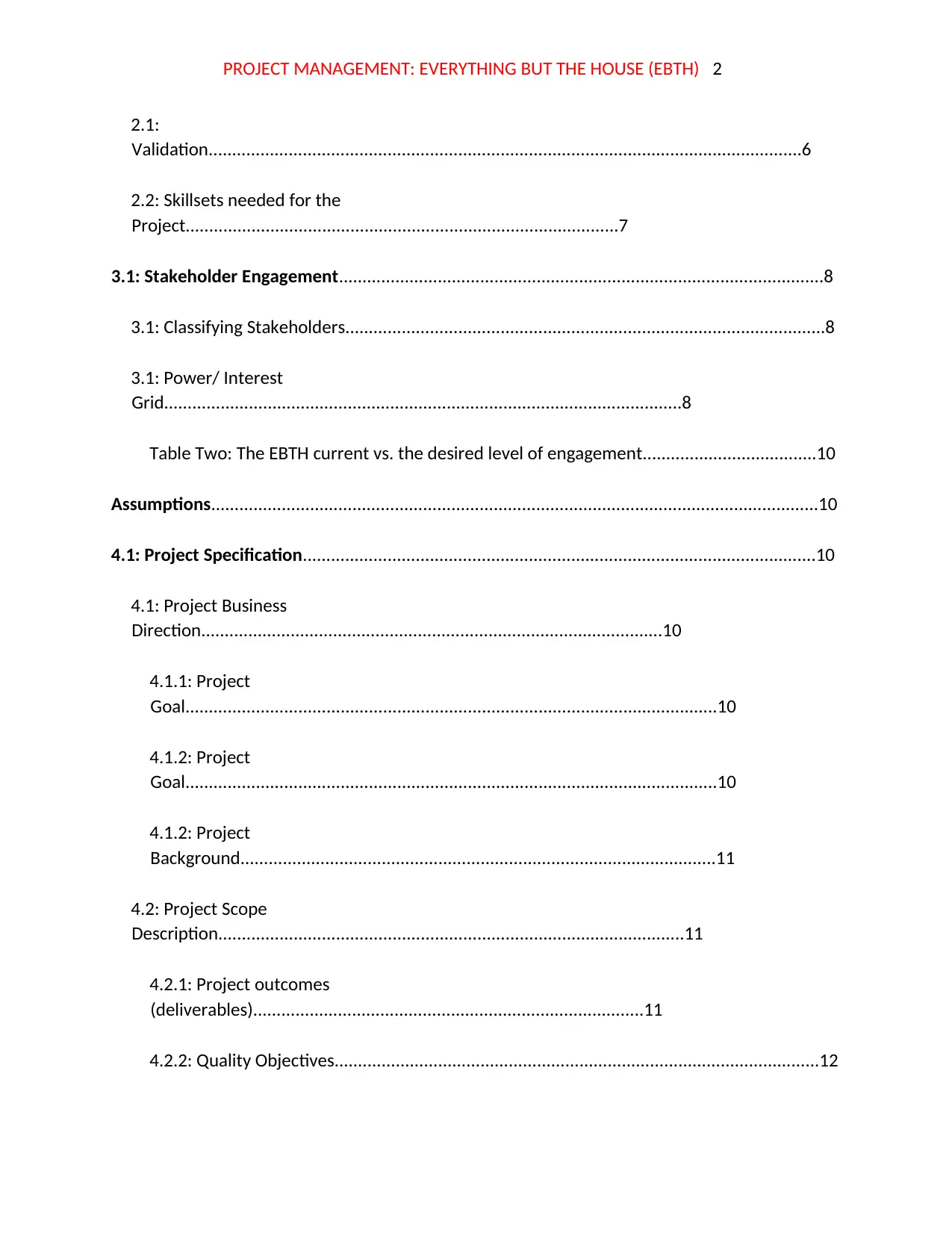
PROJECT MANAGEMENT: EVERYTHING BUT THE HOUSE (EBTH) 2
2.1:
Validation..............................................................................................................................6
2.2: Skillsets needed for the
Project............................................................................................7
3.1: Stakeholder Engagement.......................................................................................................8
3.1: Classifying Stakeholders......................................................................................................8
3.1: Power/ Interest
Grid..............................................................................................................8
Table Two: The EBTH current vs. the desired level of engagement.....................................10
Assumptions.................................................................................................................................10
4.1: Project Specification.............................................................................................................10
4.1: Project Business
Direction..................................................................................................10
4.1.1: Project
Goal.................................................................................................................10
4.1.2: Project
Goal.................................................................................................................10
4.1.2: Project
Background.....................................................................................................11
4.2: Project Scope
Description...................................................................................................11
4.2.1: Project outcomes
(deliverables)...................................................................................11
4.2.2: Quality Objectives.......................................................................................................12
2.1:
Validation..............................................................................................................................6
2.2: Skillsets needed for the
Project............................................................................................7
3.1: Stakeholder Engagement.......................................................................................................8
3.1: Classifying Stakeholders......................................................................................................8
3.1: Power/ Interest
Grid..............................................................................................................8
Table Two: The EBTH current vs. the desired level of engagement.....................................10
Assumptions.................................................................................................................................10
4.1: Project Specification.............................................................................................................10
4.1: Project Business
Direction..................................................................................................10
4.1.1: Project
Goal.................................................................................................................10
4.1.2: Project
Goal.................................................................................................................10
4.1.2: Project
Background.....................................................................................................11
4.2: Project Scope
Description...................................................................................................11
4.2.1: Project outcomes
(deliverables)...................................................................................11
4.2.2: Quality Objectives.......................................................................................................12
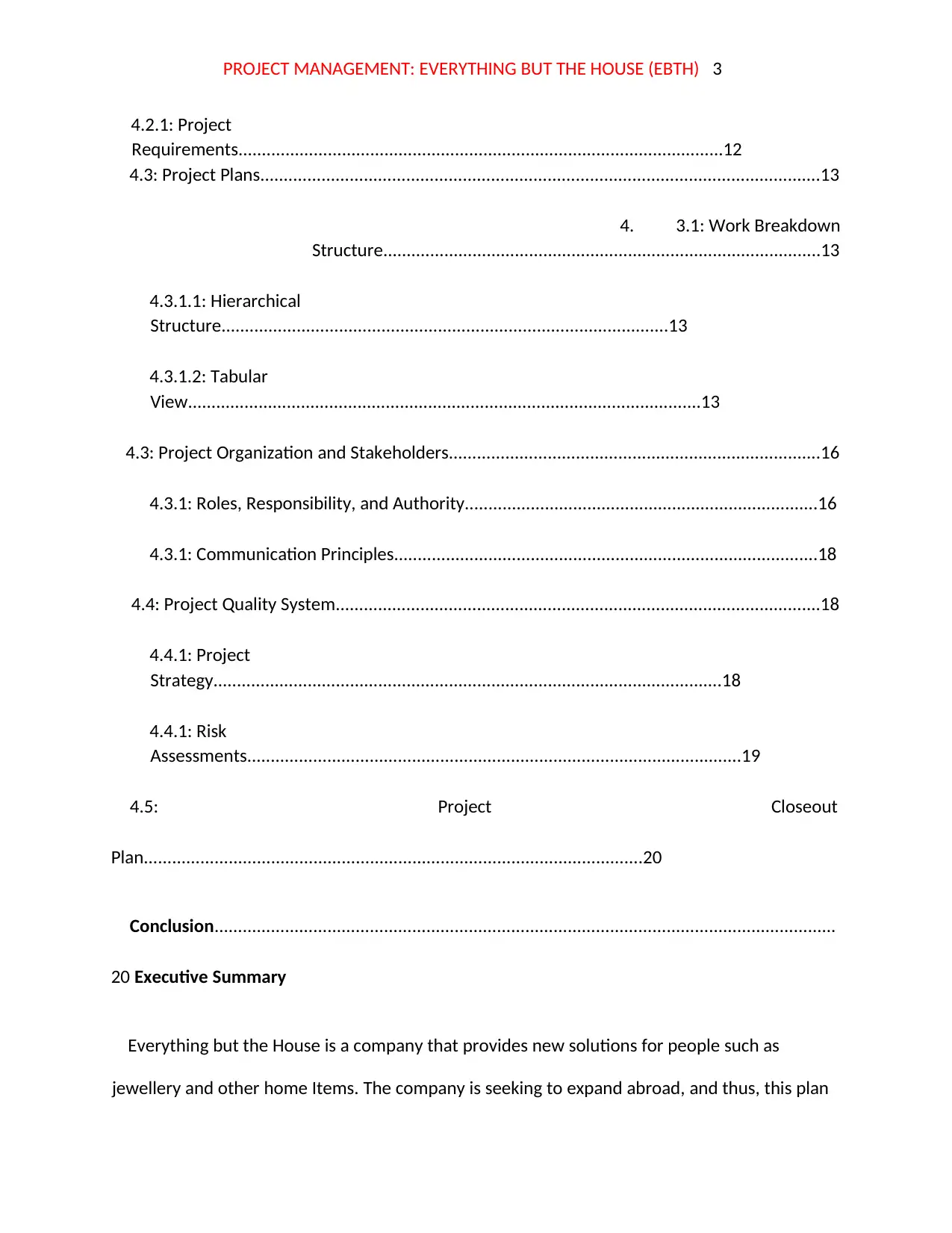
PROJECT MANAGEMENT: EVERYTHING BUT THE HOUSE (EBTH) 3
4.2.1: Project
Requirements.......................................................................................................12
4.3: Project Plans.......................................................................................................................13
4. 3.1: Work Breakdown
Structure.............................................................................................13
4.3.1.1: Hierarchical
Structure...............................................................................................13
4.3.1.2: Tabular
View.............................................................................................................13
4.3: Project Organization and Stakeholders...............................................................................16
4.3.1: Roles, Responsibility, and Authority...........................................................................16
4.3.1: Communication Principles..........................................................................................18
4.4: Project Quality System.......................................................................................................18
4.4.1: Project
Strategy............................................................................................................18
4.4.1: Risk
Assessments.........................................................................................................19
4.5: Project Closeout
Plan..........................................................................................................20
Conclusion....................................................................................................................................
20 Executive Summary
Everything but the House is a company that provides new solutions for people such as
jewellery and other home Items. The company is seeking to expand abroad, and thus, this plan
4.2.1: Project
Requirements.......................................................................................................12
4.3: Project Plans.......................................................................................................................13
4. 3.1: Work Breakdown
Structure.............................................................................................13
4.3.1.1: Hierarchical
Structure...............................................................................................13
4.3.1.2: Tabular
View.............................................................................................................13
4.3: Project Organization and Stakeholders...............................................................................16
4.3.1: Roles, Responsibility, and Authority...........................................................................16
4.3.1: Communication Principles..........................................................................................18
4.4: Project Quality System.......................................................................................................18
4.4.1: Project
Strategy............................................................................................................18
4.4.1: Risk
Assessments.........................................................................................................19
4.5: Project Closeout
Plan..........................................................................................................20
Conclusion....................................................................................................................................
20 Executive Summary
Everything but the House is a company that provides new solutions for people such as
jewellery and other home Items. The company is seeking to expand abroad, and thus, this plan
⊘ This is a preview!⊘
Do you want full access?
Subscribe today to unlock all pages.

Trusted by 1+ million students worldwide
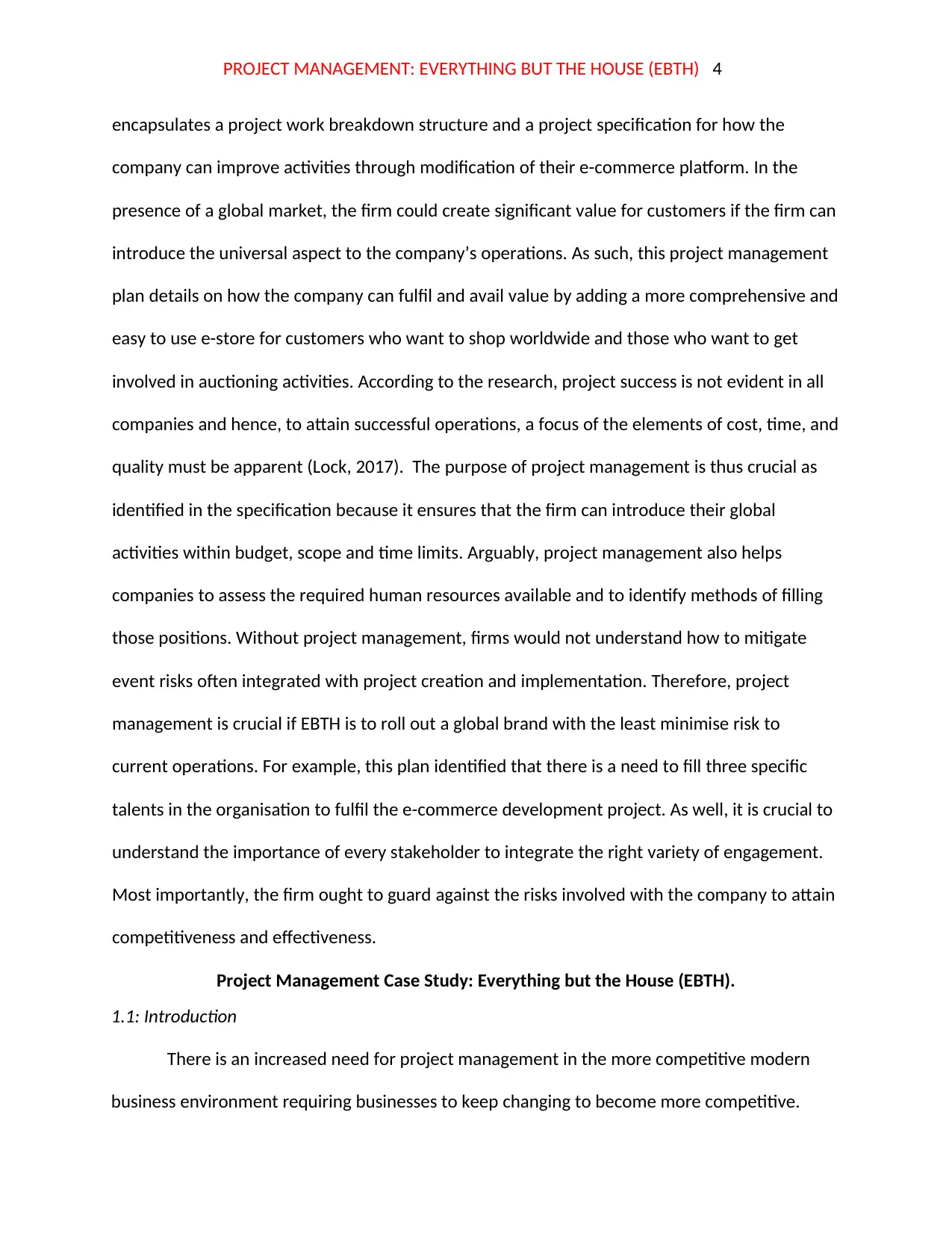
PROJECT MANAGEMENT: EVERYTHING BUT THE HOUSE (EBTH) 4
encapsulates a project work breakdown structure and a project specification for how the
company can improve activities through modification of their e-commerce platform. In the
presence of a global market, the firm could create significant value for customers if the firm can
introduce the universal aspect to the company’s operations. As such, this project management
plan details on how the company can fulfil and avail value by adding a more comprehensive and
easy to use e-store for customers who want to shop worldwide and those who want to get
involved in auctioning activities. According to the research, project success is not evident in all
companies and hence, to attain successful operations, a focus of the elements of cost, time, and
quality must be apparent (Lock, 2017). The purpose of project management is thus crucial as
identified in the specification because it ensures that the firm can introduce their global
activities within budget, scope and time limits. Arguably, project management also helps
companies to assess the required human resources available and to identify methods of filling
those positions. Without project management, firms would not understand how to mitigate
event risks often integrated with project creation and implementation. Therefore, project
management is crucial if EBTH is to roll out a global brand with the least minimise risk to
current operations. For example, this plan identified that there is a need to fill three specific
talents in the organisation to fulfil the e-commerce development project. As well, it is crucial to
understand the importance of every stakeholder to integrate the right variety of engagement.
Most importantly, the firm ought to guard against the risks involved with the company to attain
competitiveness and effectiveness.
Project Management Case Study: Everything but the House (EBTH).
1.1: Introduction
There is an increased need for project management in the more competitive modern
business environment requiring businesses to keep changing to become more competitive.
encapsulates a project work breakdown structure and a project specification for how the
company can improve activities through modification of their e-commerce platform. In the
presence of a global market, the firm could create significant value for customers if the firm can
introduce the universal aspect to the company’s operations. As such, this project management
plan details on how the company can fulfil and avail value by adding a more comprehensive and
easy to use e-store for customers who want to shop worldwide and those who want to get
involved in auctioning activities. According to the research, project success is not evident in all
companies and hence, to attain successful operations, a focus of the elements of cost, time, and
quality must be apparent (Lock, 2017). The purpose of project management is thus crucial as
identified in the specification because it ensures that the firm can introduce their global
activities within budget, scope and time limits. Arguably, project management also helps
companies to assess the required human resources available and to identify methods of filling
those positions. Without project management, firms would not understand how to mitigate
event risks often integrated with project creation and implementation. Therefore, project
management is crucial if EBTH is to roll out a global brand with the least minimise risk to
current operations. For example, this plan identified that there is a need to fill three specific
talents in the organisation to fulfil the e-commerce development project. As well, it is crucial to
understand the importance of every stakeholder to integrate the right variety of engagement.
Most importantly, the firm ought to guard against the risks involved with the company to attain
competitiveness and effectiveness.
Project Management Case Study: Everything but the House (EBTH).
1.1: Introduction
There is an increased need for project management in the more competitive modern
business environment requiring businesses to keep changing to become more competitive.
Paraphrase This Document
Need a fresh take? Get an instant paraphrase of this document with our AI Paraphraser
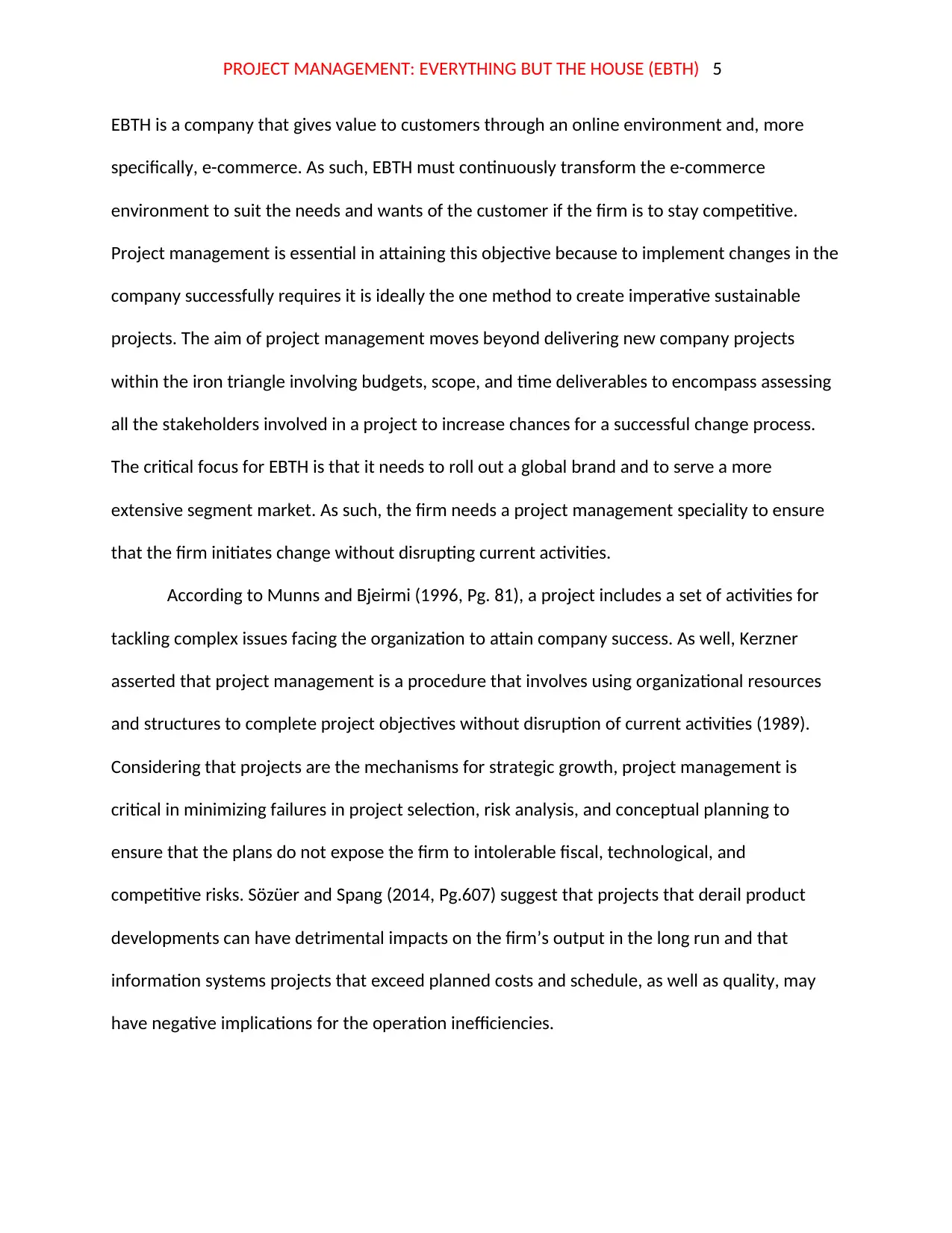
PROJECT MANAGEMENT: EVERYTHING BUT THE HOUSE (EBTH) 5
EBTH is a company that gives value to customers through an online environment and, more
specifically, e-commerce. As such, EBTH must continuously transform the e-commerce
environment to suit the needs and wants of the customer if the firm is to stay competitive.
Project management is essential in attaining this objective because to implement changes in the
company successfully requires it is ideally the one method to create imperative sustainable
projects. The aim of project management moves beyond delivering new company projects
within the iron triangle involving budgets, scope, and time deliverables to encompass assessing
all the stakeholders involved in a project to increase chances for a successful change process.
The critical focus for EBTH is that it needs to roll out a global brand and to serve a more
extensive segment market. As such, the firm needs a project management speciality to ensure
that the firm initiates change without disrupting current activities.
According to Munns and Bjeirmi (1996, Pg. 81), a project includes a set of activities for
tackling complex issues facing the organization to attain company success. As well, Kerzner
asserted that project management is a procedure that involves using organizational resources
and structures to complete project objectives without disruption of current activities (1989).
Considering that projects are the mechanisms for strategic growth, project management is
critical in minimizing failures in project selection, risk analysis, and conceptual planning to
ensure that the plans do not expose the firm to intolerable fiscal, technological, and
competitive risks. Sözüer and Spang (2014, Pg.607) suggest that projects that derail product
developments can have detrimental impacts on the firm’s output in the long run and that
information systems projects that exceed planned costs and schedule, as well as quality, may
have negative implications for the operation inefficiencies.
EBTH is a company that gives value to customers through an online environment and, more
specifically, e-commerce. As such, EBTH must continuously transform the e-commerce
environment to suit the needs and wants of the customer if the firm is to stay competitive.
Project management is essential in attaining this objective because to implement changes in the
company successfully requires it is ideally the one method to create imperative sustainable
projects. The aim of project management moves beyond delivering new company projects
within the iron triangle involving budgets, scope, and time deliverables to encompass assessing
all the stakeholders involved in a project to increase chances for a successful change process.
The critical focus for EBTH is that it needs to roll out a global brand and to serve a more
extensive segment market. As such, the firm needs a project management speciality to ensure
that the firm initiates change without disrupting current activities.
According to Munns and Bjeirmi (1996, Pg. 81), a project includes a set of activities for
tackling complex issues facing the organization to attain company success. As well, Kerzner
asserted that project management is a procedure that involves using organizational resources
and structures to complete project objectives without disruption of current activities (1989).
Considering that projects are the mechanisms for strategic growth, project management is
critical in minimizing failures in project selection, risk analysis, and conceptual planning to
ensure that the plans do not expose the firm to intolerable fiscal, technological, and
competitive risks. Sözüer and Spang (2014, Pg.607) suggest that projects that derail product
developments can have detrimental impacts on the firm’s output in the long run and that
information systems projects that exceed planned costs and schedule, as well as quality, may
have negative implications for the operation inefficiencies.
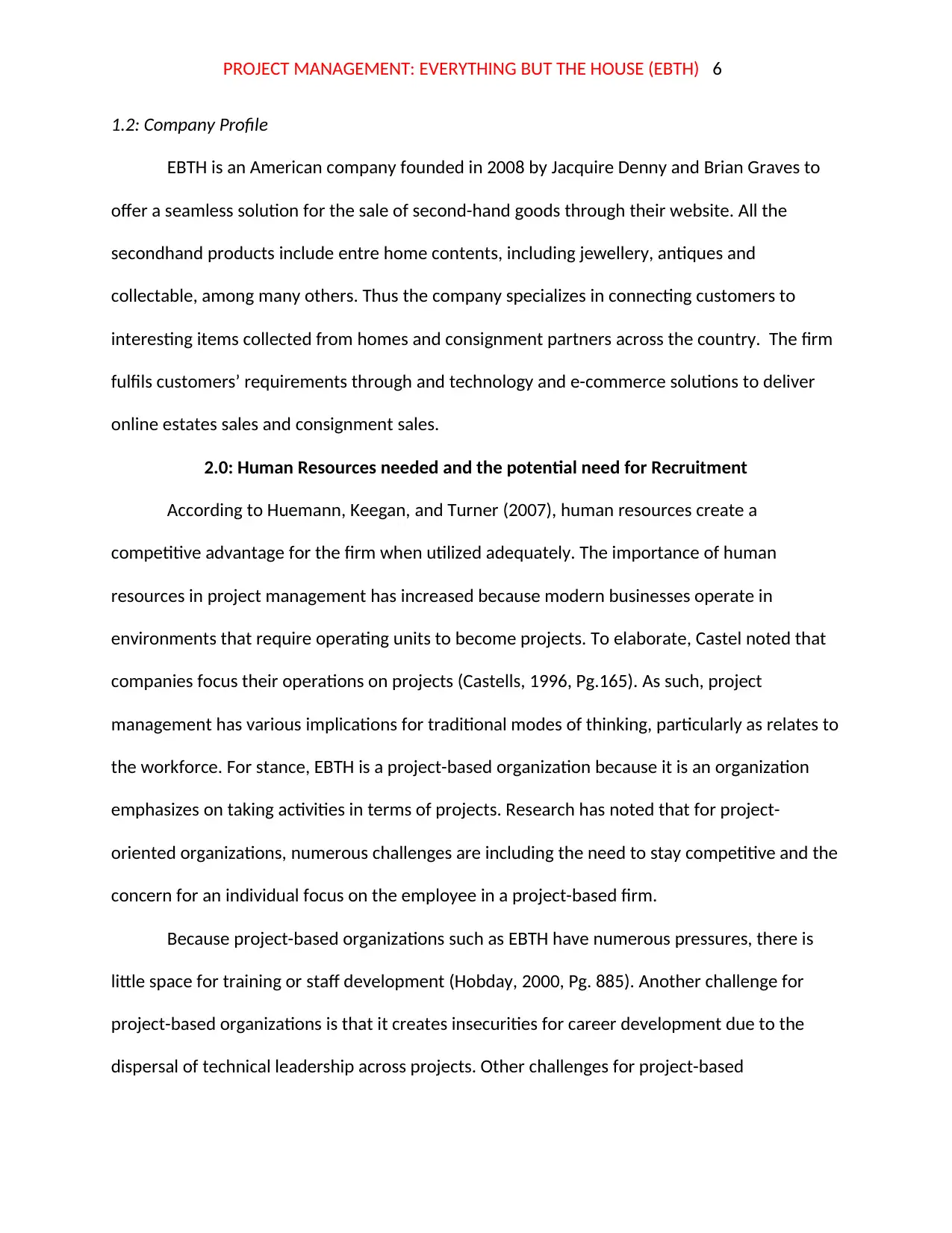
PROJECT MANAGEMENT: EVERYTHING BUT THE HOUSE (EBTH) 6
1.2: Company Profile
EBTH is an American company founded in 2008 by Jacquire Denny and Brian Graves to
offer a seamless solution for the sale of second-hand goods through their website. All the
secondhand products include entre home contents, including jewellery, antiques and
collectable, among many others. Thus the company specializes in connecting customers to
interesting items collected from homes and consignment partners across the country. The firm
fulfils customers’ requirements through and technology and e-commerce solutions to deliver
online estates sales and consignment sales.
2.0: Human Resources needed and the potential need for Recruitment
According to Huemann, Keegan, and Turner (2007), human resources create a
competitive advantage for the firm when utilized adequately. The importance of human
resources in project management has increased because modern businesses operate in
environments that require operating units to become projects. To elaborate, Castel noted that
companies focus their operations on projects (Castells, 1996, Pg.165). As such, project
management has various implications for traditional modes of thinking, particularly as relates to
the workforce. For stance, EBTH is a project-based organization because it is an organization
emphasizes on taking activities in terms of projects. Research has noted that for project-
oriented organizations, numerous challenges are including the need to stay competitive and the
concern for an individual focus on the employee in a project-based firm.
Because project-based organizations such as EBTH have numerous pressures, there is
little space for training or staff development (Hobday, 2000, Pg. 885). Another challenge for
project-based organizations is that it creates insecurities for career development due to the
dispersal of technical leadership across projects. Other challenges for project-based
1.2: Company Profile
EBTH is an American company founded in 2008 by Jacquire Denny and Brian Graves to
offer a seamless solution for the sale of second-hand goods through their website. All the
secondhand products include entre home contents, including jewellery, antiques and
collectable, among many others. Thus the company specializes in connecting customers to
interesting items collected from homes and consignment partners across the country. The firm
fulfils customers’ requirements through and technology and e-commerce solutions to deliver
online estates sales and consignment sales.
2.0: Human Resources needed and the potential need for Recruitment
According to Huemann, Keegan, and Turner (2007), human resources create a
competitive advantage for the firm when utilized adequately. The importance of human
resources in project management has increased because modern businesses operate in
environments that require operating units to become projects. To elaborate, Castel noted that
companies focus their operations on projects (Castells, 1996, Pg.165). As such, project
management has various implications for traditional modes of thinking, particularly as relates to
the workforce. For stance, EBTH is a project-based organization because it is an organization
emphasizes on taking activities in terms of projects. Research has noted that for project-
oriented organizations, numerous challenges are including the need to stay competitive and the
concern for an individual focus on the employee in a project-based firm.
Because project-based organizations such as EBTH have numerous pressures, there is
little space for training or staff development (Hobday, 2000, Pg. 885). Another challenge for
project-based organizations is that it creates insecurities for career development due to the
dispersal of technical leadership across projects. Other challenges for project-based
⊘ This is a preview!⊘
Do you want full access?
Subscribe today to unlock all pages.

Trusted by 1+ million students worldwide
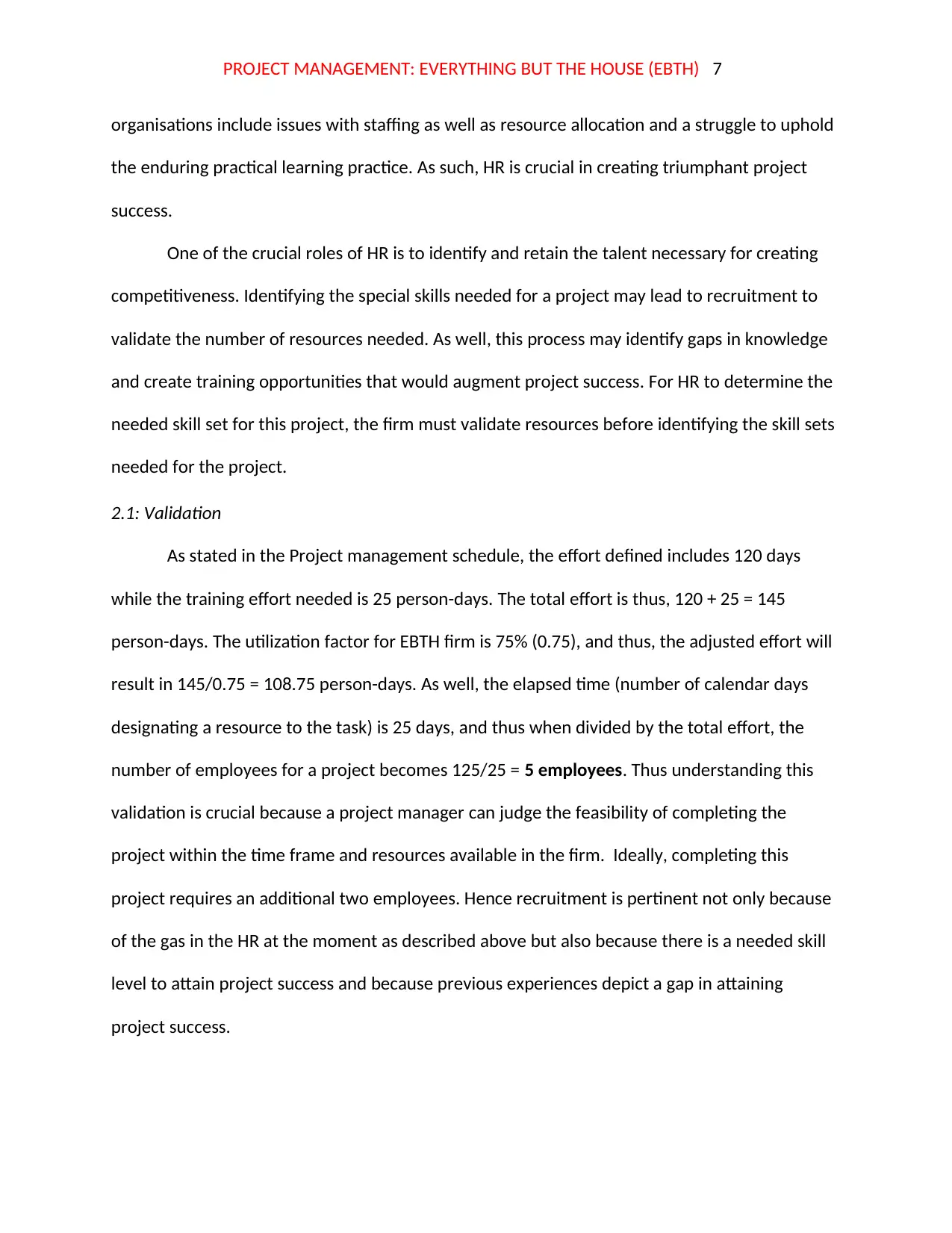
PROJECT MANAGEMENT: EVERYTHING BUT THE HOUSE (EBTH) 7
organisations include issues with staffing as well as resource allocation and a struggle to uphold
the enduring practical learning practice. As such, HR is crucial in creating triumphant project
success.
One of the crucial roles of HR is to identify and retain the talent necessary for creating
competitiveness. Identifying the special skills needed for a project may lead to recruitment to
validate the number of resources needed. As well, this process may identify gaps in knowledge
and create training opportunities that would augment project success. For HR to determine the
needed skill set for this project, the firm must validate resources before identifying the skill sets
needed for the project.
2.1: Validation
As stated in the Project management schedule, the effort defined includes 120 days
while the training effort needed is 25 person-days. The total effort is thus, 120 + 25 = 145
person-days. The utilization factor for EBTH firm is 75% (0.75), and thus, the adjusted effort will
result in 145/0.75 = 108.75 person-days. As well, the elapsed time (number of calendar days
designating a resource to the task) is 25 days, and thus when divided by the total effort, the
number of employees for a project becomes 125/25 = 5 employees. Thus understanding this
validation is crucial because a project manager can judge the feasibility of completing the
project within the time frame and resources available in the firm. Ideally, completing this
project requires an additional two employees. Hence recruitment is pertinent not only because
of the gas in the HR at the moment as described above but also because there is a needed skill
level to attain project success and because previous experiences depict a gap in attaining
project success.
organisations include issues with staffing as well as resource allocation and a struggle to uphold
the enduring practical learning practice. As such, HR is crucial in creating triumphant project
success.
One of the crucial roles of HR is to identify and retain the talent necessary for creating
competitiveness. Identifying the special skills needed for a project may lead to recruitment to
validate the number of resources needed. As well, this process may identify gaps in knowledge
and create training opportunities that would augment project success. For HR to determine the
needed skill set for this project, the firm must validate resources before identifying the skill sets
needed for the project.
2.1: Validation
As stated in the Project management schedule, the effort defined includes 120 days
while the training effort needed is 25 person-days. The total effort is thus, 120 + 25 = 145
person-days. The utilization factor for EBTH firm is 75% (0.75), and thus, the adjusted effort will
result in 145/0.75 = 108.75 person-days. As well, the elapsed time (number of calendar days
designating a resource to the task) is 25 days, and thus when divided by the total effort, the
number of employees for a project becomes 125/25 = 5 employees. Thus understanding this
validation is crucial because a project manager can judge the feasibility of completing the
project within the time frame and resources available in the firm. Ideally, completing this
project requires an additional two employees. Hence recruitment is pertinent not only because
of the gas in the HR at the moment as described above but also because there is a needed skill
level to attain project success and because previous experiences depict a gap in attaining
project success.
Paraphrase This Document
Need a fresh take? Get an instant paraphrase of this document with our AI Paraphraser
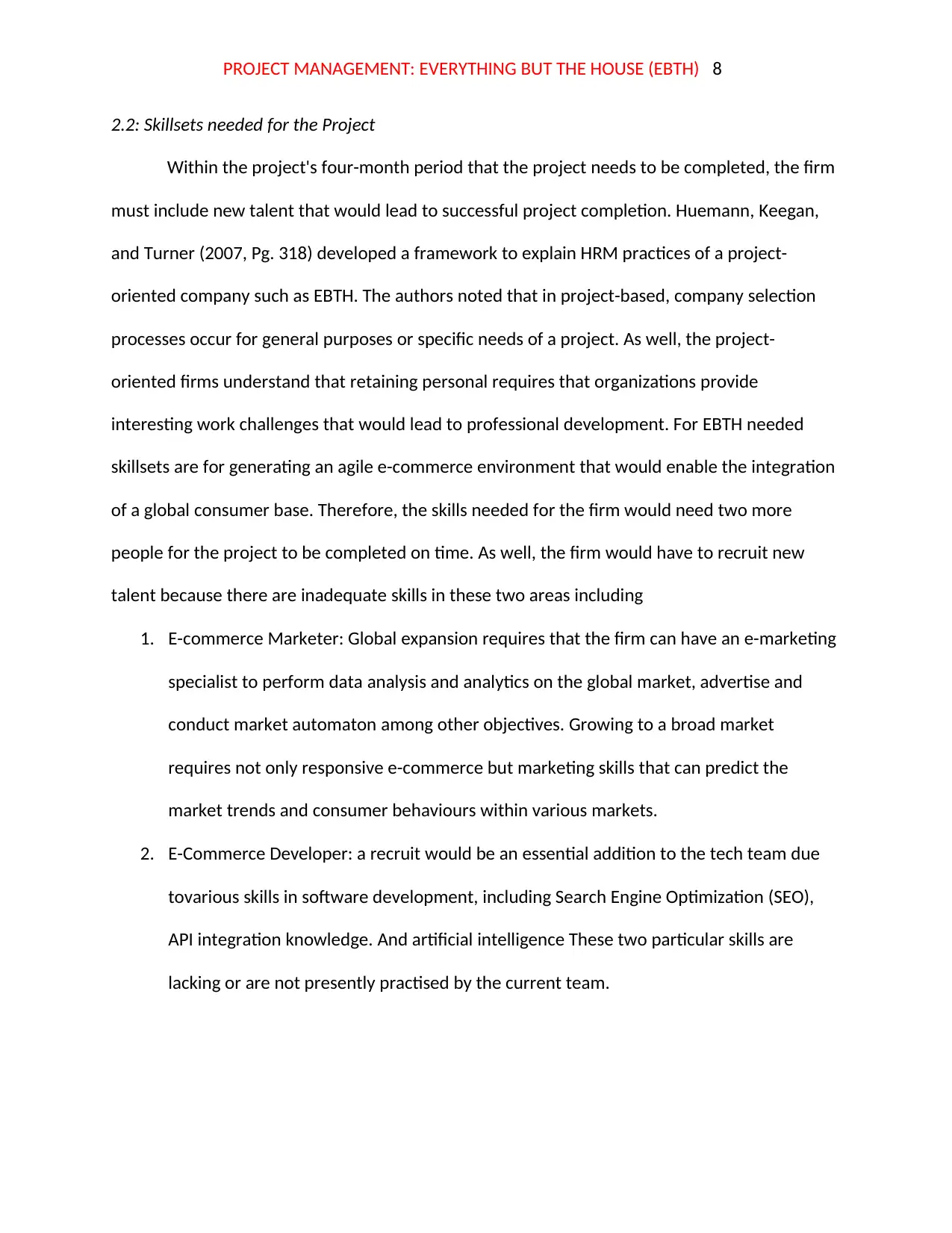
PROJECT MANAGEMENT: EVERYTHING BUT THE HOUSE (EBTH) 8
2.2: Skillsets needed for the Project
Within the project's four-month period that the project needs to be completed, the firm
must include new talent that would lead to successful project completion. Huemann, Keegan,
and Turner (2007, Pg. 318) developed a framework to explain HRM practices of a project-
oriented company such as EBTH. The authors noted that in project-based, company selection
processes occur for general purposes or specific needs of a project. As well, the project-
oriented firms understand that retaining personal requires that organizations provide
interesting work challenges that would lead to professional development. For EBTH needed
skillsets are for generating an agile e-commerce environment that would enable the integration
of a global consumer base. Therefore, the skills needed for the firm would need two more
people for the project to be completed on time. As well, the firm would have to recruit new
talent because there are inadequate skills in these two areas including
1. E-commerce Marketer: Global expansion requires that the firm can have an e-marketing
specialist to perform data analysis and analytics on the global market, advertise and
conduct market automaton among other objectives. Growing to a broad market
requires not only responsive e-commerce but marketing skills that can predict the
market trends and consumer behaviours within various markets.
2. E-Commerce Developer: a recruit would be an essential addition to the tech team due
tovarious skills in software development, including Search Engine Optimization (SEO),
API integration knowledge. And artificial intelligence These two particular skills are
lacking or are not presently practised by the current team.
2.2: Skillsets needed for the Project
Within the project's four-month period that the project needs to be completed, the firm
must include new talent that would lead to successful project completion. Huemann, Keegan,
and Turner (2007, Pg. 318) developed a framework to explain HRM practices of a project-
oriented company such as EBTH. The authors noted that in project-based, company selection
processes occur for general purposes or specific needs of a project. As well, the project-
oriented firms understand that retaining personal requires that organizations provide
interesting work challenges that would lead to professional development. For EBTH needed
skillsets are for generating an agile e-commerce environment that would enable the integration
of a global consumer base. Therefore, the skills needed for the firm would need two more
people for the project to be completed on time. As well, the firm would have to recruit new
talent because there are inadequate skills in these two areas including
1. E-commerce Marketer: Global expansion requires that the firm can have an e-marketing
specialist to perform data analysis and analytics on the global market, advertise and
conduct market automaton among other objectives. Growing to a broad market
requires not only responsive e-commerce but marketing skills that can predict the
market trends and consumer behaviours within various markets.
2. E-Commerce Developer: a recruit would be an essential addition to the tech team due
tovarious skills in software development, including Search Engine Optimization (SEO),
API integration knowledge. And artificial intelligence These two particular skills are
lacking or are not presently practised by the current team.
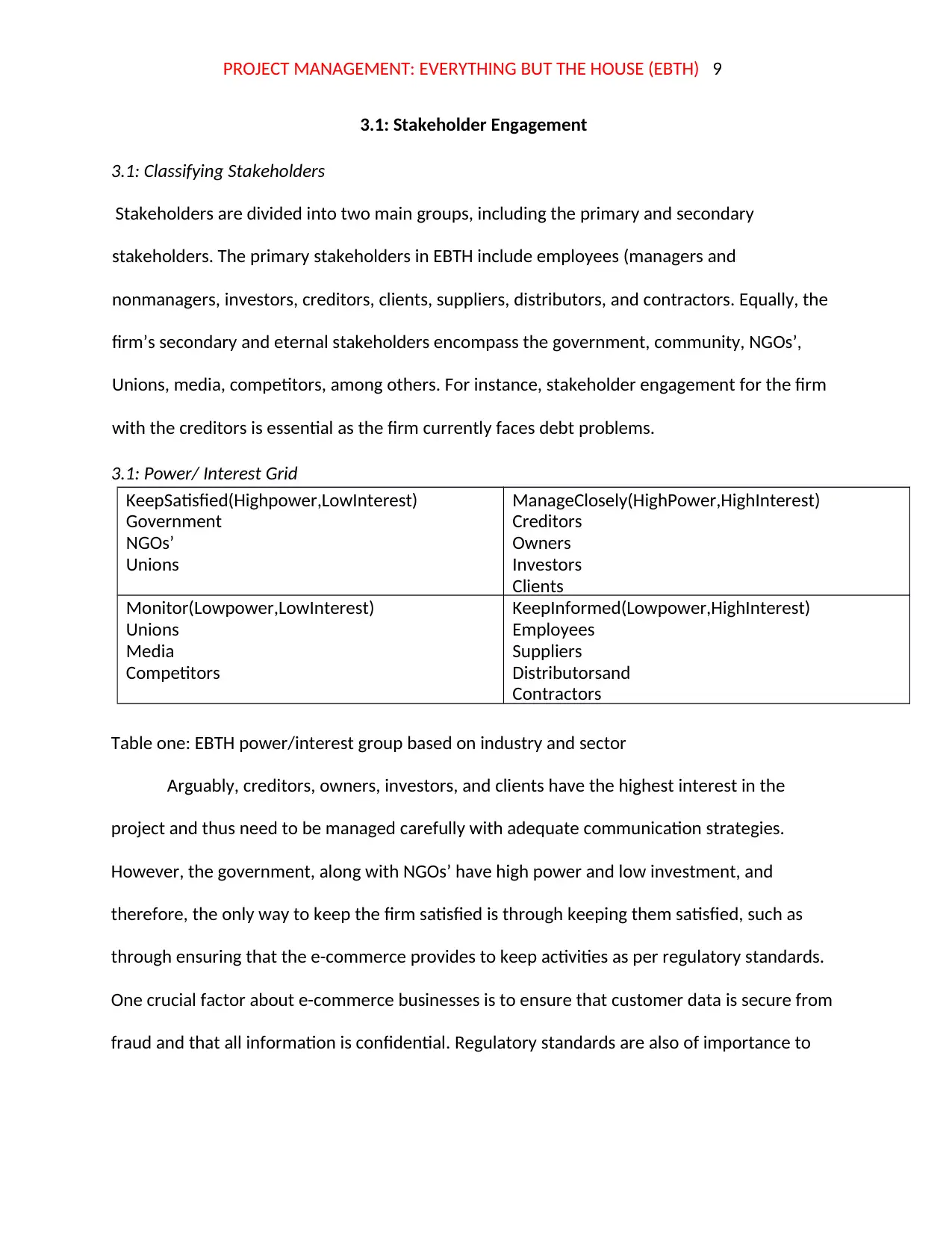
KeepSatisfied(Highpower,LowInterest)
Government
NGOs’
Unions
ManageClosely(HighPower,HighInterest)
Creditors
Owners
Investors
Clients
Monitor(Lowpower,LowInterest)
Unions
Media
Competitors
KeepInformed(Lowpower,HighInterest)
Employees
Suppliers
Distributorsand
Contractors
PROJECT MANAGEMENT: EVERYTHING BUT THE HOUSE (EBTH) 9
3.1: Stakeholder Engagement
3.1: Classifying Stakeholders
Stakeholders are divided into two main groups, including the primary and secondary
stakeholders. The primary stakeholders in EBTH include employees (managers and
nonmanagers, investors, creditors, clients, suppliers, distributors, and contractors. Equally, the
firm’s secondary and eternal stakeholders encompass the government, community, NGOs’,
Unions, media, competitors, among others. For instance, stakeholder engagement for the firm
with the creditors is essential as the firm currently faces debt problems.
3.1: Power/ Interest Grid
Table one: EBTH power/interest group based on industry and sector
Arguably, creditors, owners, investors, and clients have the highest interest in the
project and thus need to be managed carefully with adequate communication strategies.
However, the government, along with NGOs’ have high power and low investment, and
therefore, the only way to keep the firm satisfied is through keeping them satisfied, such as
through ensuring that the e-commerce provides to keep activities as per regulatory standards.
One crucial factor about e-commerce businesses is to ensure that customer data is secure from
fraud and that all information is confidential. Regulatory standards are also of importance to
Government
NGOs’
Unions
ManageClosely(HighPower,HighInterest)
Creditors
Owners
Investors
Clients
Monitor(Lowpower,LowInterest)
Unions
Media
Competitors
KeepInformed(Lowpower,HighInterest)
Employees
Suppliers
Distributorsand
Contractors
PROJECT MANAGEMENT: EVERYTHING BUT THE HOUSE (EBTH) 9
3.1: Stakeholder Engagement
3.1: Classifying Stakeholders
Stakeholders are divided into two main groups, including the primary and secondary
stakeholders. The primary stakeholders in EBTH include employees (managers and
nonmanagers, investors, creditors, clients, suppliers, distributors, and contractors. Equally, the
firm’s secondary and eternal stakeholders encompass the government, community, NGOs’,
Unions, media, competitors, among others. For instance, stakeholder engagement for the firm
with the creditors is essential as the firm currently faces debt problems.
3.1: Power/ Interest Grid
Table one: EBTH power/interest group based on industry and sector
Arguably, creditors, owners, investors, and clients have the highest interest in the
project and thus need to be managed carefully with adequate communication strategies.
However, the government, along with NGOs’ have high power and low investment, and
therefore, the only way to keep the firm satisfied is through keeping them satisfied, such as
through ensuring that the e-commerce provides to keep activities as per regulatory standards.
One crucial factor about e-commerce businesses is to ensure that customer data is secure from
fraud and that all information is confidential. Regulatory standards are also of importance to
⊘ This is a preview!⊘
Do you want full access?
Subscribe today to unlock all pages.

Trusted by 1+ million students worldwide

PROJECT MANAGEMENT: EVERYTHING BUT THE HOUSE (EBTH) 10
NGOs’ as these organisations expect the firm to keep all business activities in line with human
rights and that the
NGOs’ as these organisations expect the firm to keep all business activities in line with human
rights and that the
Paraphrase This Document
Need a fresh take? Get an instant paraphrase of this document with our AI Paraphraser
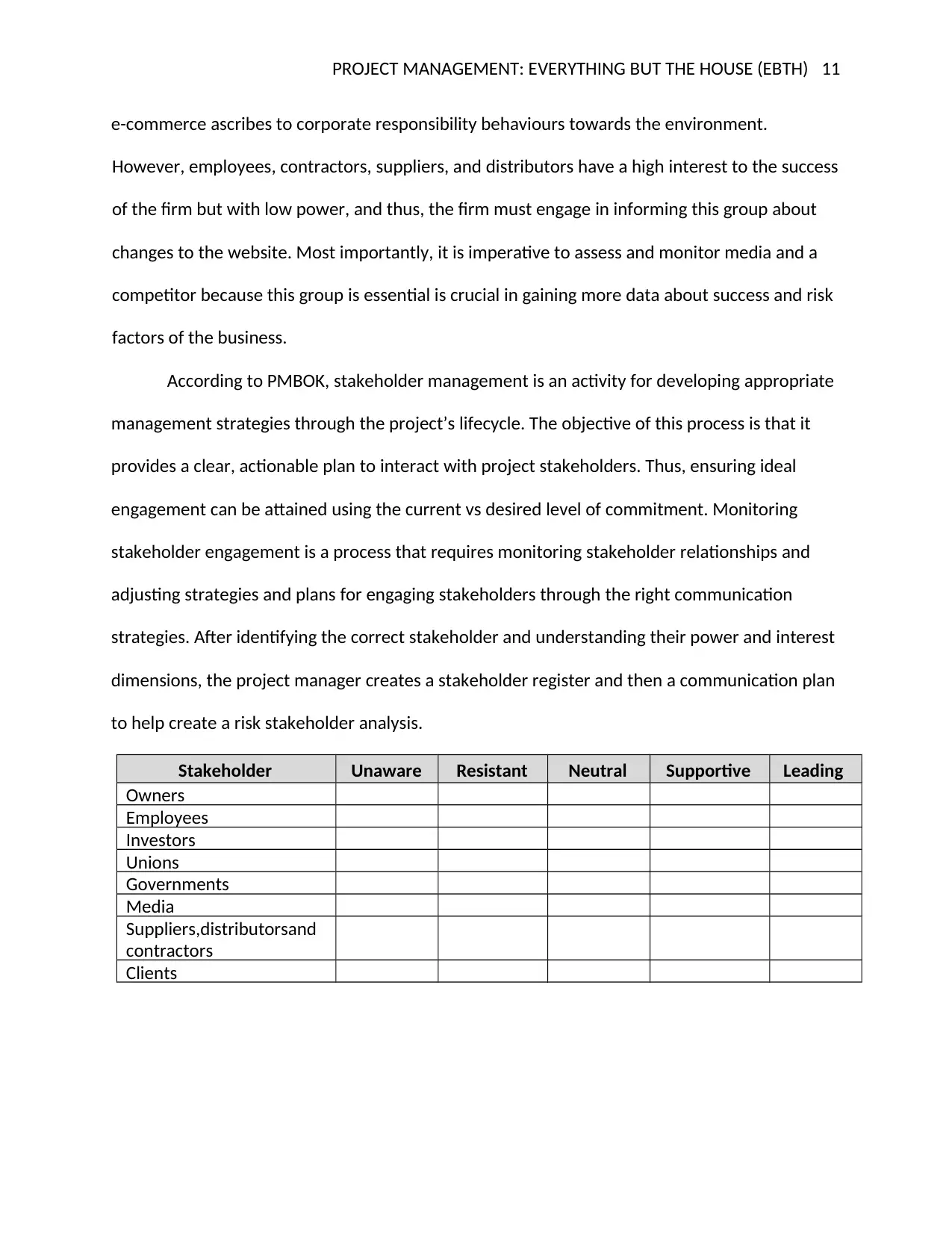
Stakeholder Unaware Resistant Neutral Supportive Leading
Owners
Employees
Investors
Unions
Governments
Media
Suppliers,distributorsand
contractors
Clients
PROJECT MANAGEMENT: EVERYTHING BUT THE HOUSE (EBTH) 11
e-commerce ascribes to corporate responsibility behaviours towards the environment.
However, employees, contractors, suppliers, and distributors have a high interest to the success
of the firm but with low power, and thus, the firm must engage in informing this group about
changes to the website. Most importantly, it is imperative to assess and monitor media and a
competitor because this group is essential is crucial in gaining more data about success and risk
factors of the business.
According to PMBOK, stakeholder management is an activity for developing appropriate
management strategies through the project’s lifecycle. The objective of this process is that it
provides a clear, actionable plan to interact with project stakeholders. Thus, ensuring ideal
engagement can be attained using the current vs desired level of commitment. Monitoring
stakeholder engagement is a process that requires monitoring stakeholder relationships and
adjusting strategies and plans for engaging stakeholders through the right communication
strategies. After identifying the correct stakeholder and understanding their power and interest
dimensions, the project manager creates a stakeholder register and then a communication plan
to help create a risk stakeholder analysis.
Owners
Employees
Investors
Unions
Governments
Media
Suppliers,distributorsand
contractors
Clients
PROJECT MANAGEMENT: EVERYTHING BUT THE HOUSE (EBTH) 11
e-commerce ascribes to corporate responsibility behaviours towards the environment.
However, employees, contractors, suppliers, and distributors have a high interest to the success
of the firm but with low power, and thus, the firm must engage in informing this group about
changes to the website. Most importantly, it is imperative to assess and monitor media and a
competitor because this group is essential is crucial in gaining more data about success and risk
factors of the business.
According to PMBOK, stakeholder management is an activity for developing appropriate
management strategies through the project’s lifecycle. The objective of this process is that it
provides a clear, actionable plan to interact with project stakeholders. Thus, ensuring ideal
engagement can be attained using the current vs desired level of commitment. Monitoring
stakeholder engagement is a process that requires monitoring stakeholder relationships and
adjusting strategies and plans for engaging stakeholders through the right communication
strategies. After identifying the correct stakeholder and understanding their power and interest
dimensions, the project manager creates a stakeholder register and then a communication plan
to help create a risk stakeholder analysis.
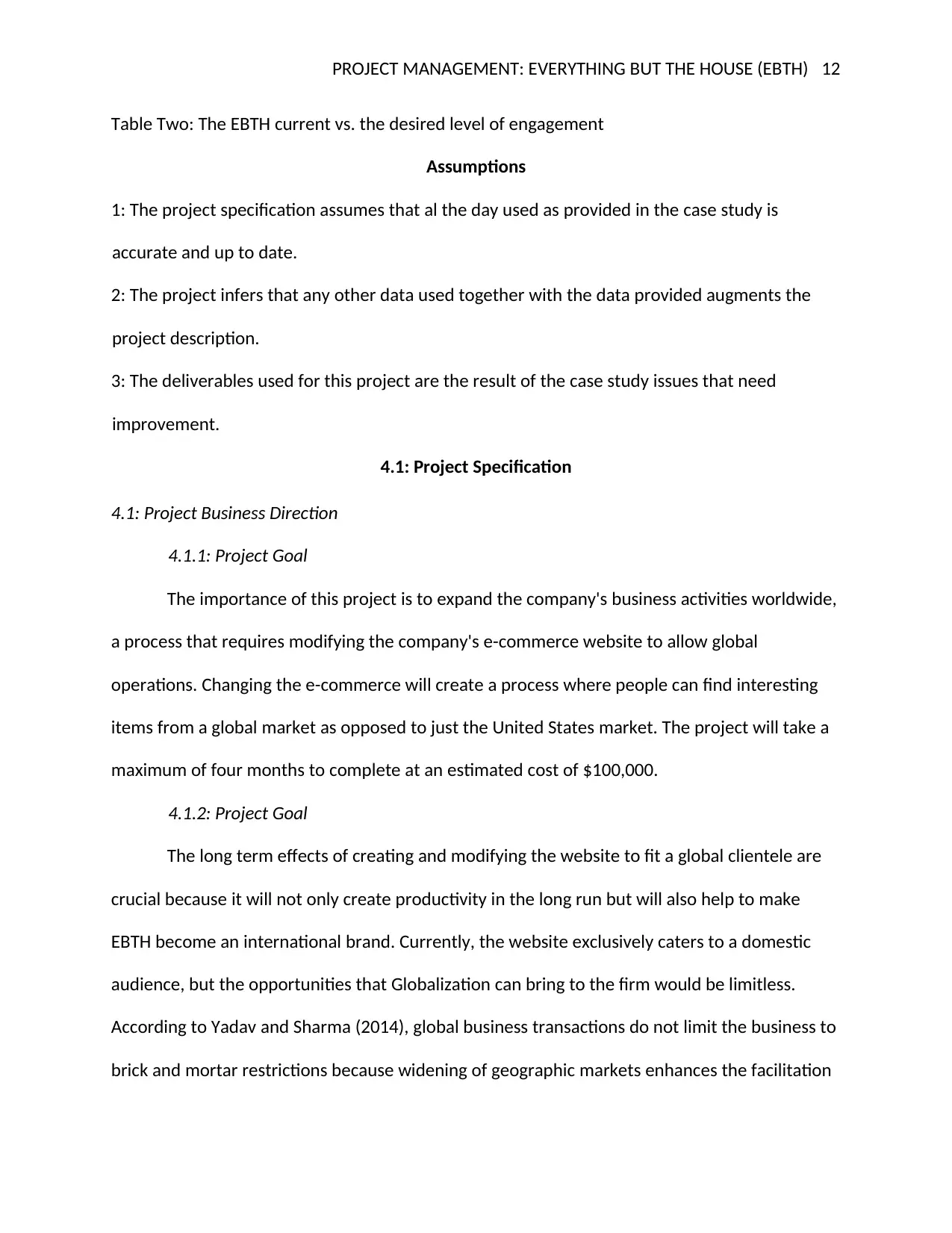
PROJECT MANAGEMENT: EVERYTHING BUT THE HOUSE (EBTH) 12
Table Two: The EBTH current vs. the desired level of engagement
Assumptions
1: The project specification assumes that al the day used as provided in the case study is
accurate and up to date.
2: The project infers that any other data used together with the data provided augments the
project description.
3: The deliverables used for this project are the result of the case study issues that need
improvement.
4.1: Project Specification
4.1: Project Business Direction
4.1.1: Project Goal
The importance of this project is to expand the company's business activities worldwide,
a process that requires modifying the company's e-commerce website to allow global
operations. Changing the e-commerce will create a process where people can find interesting
items from a global market as opposed to just the United States market. The project will take a
maximum of four months to complete at an estimated cost of $100,000.
4.1.2: Project Goal
The long term effects of creating and modifying the website to fit a global clientele are
crucial because it will not only create productivity in the long run but will also help to make
EBTH become an international brand. Currently, the website exclusively caters to a domestic
audience, but the opportunities that Globalization can bring to the firm would be limitless.
According to Yadav and Sharma (2014), global business transactions do not limit the business to
brick and mortar restrictions because widening of geographic markets enhances the facilitation
Table Two: The EBTH current vs. the desired level of engagement
Assumptions
1: The project specification assumes that al the day used as provided in the case study is
accurate and up to date.
2: The project infers that any other data used together with the data provided augments the
project description.
3: The deliverables used for this project are the result of the case study issues that need
improvement.
4.1: Project Specification
4.1: Project Business Direction
4.1.1: Project Goal
The importance of this project is to expand the company's business activities worldwide,
a process that requires modifying the company's e-commerce website to allow global
operations. Changing the e-commerce will create a process where people can find interesting
items from a global market as opposed to just the United States market. The project will take a
maximum of four months to complete at an estimated cost of $100,000.
4.1.2: Project Goal
The long term effects of creating and modifying the website to fit a global clientele are
crucial because it will not only create productivity in the long run but will also help to make
EBTH become an international brand. Currently, the website exclusively caters to a domestic
audience, but the opportunities that Globalization can bring to the firm would be limitless.
According to Yadav and Sharma (2014), global business transactions do not limit the business to
brick and mortar restrictions because widening of geographic markets enhances the facilitation
⊘ This is a preview!⊘
Do you want full access?
Subscribe today to unlock all pages.

Trusted by 1+ million students worldwide
1 out of 26
Related Documents
Your All-in-One AI-Powered Toolkit for Academic Success.
+13062052269
info@desklib.com
Available 24*7 on WhatsApp / Email
![[object Object]](/_next/static/media/star-bottom.7253800d.svg)
Unlock your academic potential
Copyright © 2020–2025 A2Z Services. All Rights Reserved. Developed and managed by ZUCOL.



